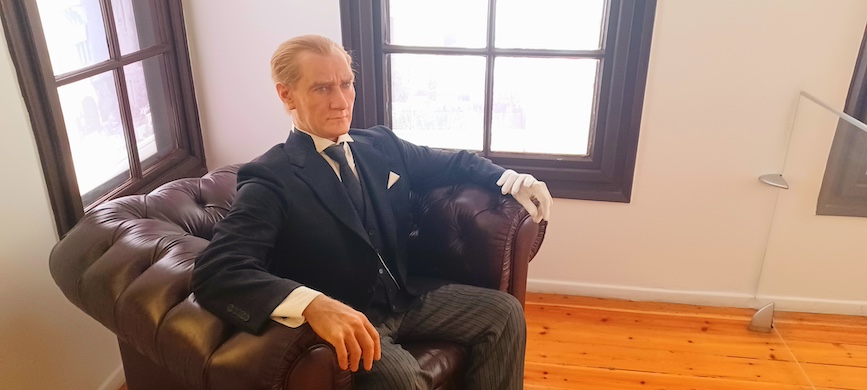Unpacked: Thessaloniki Tempts With Greek Bagels and History Galore, but There Is No Hiding Some of Europe’s Deepest Scars
A fabled Greek port city with a 2,300-year Jewish presence makes for a poignant visit.

THESSALONIKI — This may be Greece’s northern second city, but it is south of Rome. It is a relaxed and surprisingly gracious kind of place, though scruffier than, say, Trieste, and wears a mottled overcoat of paradox and pathos. In this quintessentially Greek metropolis, the founding father of modern Turkey, Mustafa Kemal Atatürk, was born. Also, 96 percent of the city’s Jews, who have a 2,300-year presence here, perished in the Holocaust.
Most of the estimated 54,000 Jews who lived in this teeming and humid port city facing the Thermaic Gulf before World War II had been deported to Auschwitz by the time it was over. It was a genocide executed with a considerable degree of local connivance that also saw the destruction of the vast Jewish cemetery of Salonica, as the city used to be known.
In that necropolis were nearly half a million burials, but by 1943 the headstones were smashed and gone, eventually finding their way into the foundations of the otherwise prestigious Aristotle University of Thessaloniki.
The building of a small but poignant monument to that wholesale destruction has for about a decade now filled a tiny pocket of the vast university, but incredibly — or not — it was said to be met with more consternation than comity by some of the unwitting heirs of Thessaloniki’s calamitous cultural loss.

Those heirs include every resident of this quixotic city, for it is immutably diminished by the worlds lost when the rickety rail cars pulled out of town, loaded with their bewildered human cargo, on March 15, 1943.
As the president of the Jewish Community of Thessaloniki, David Saltiel, writes in the prologue to “Topography of Synagogues in Salonika 1500-1940,” the Holocaust “destroyed not only the lives of 50,000 Jewish Thessalonians, but also the buildings, the language, the tradition, even the memory of this city.”
When David Ben Gurion visited Thessaloniki in 1911, the city crackled with Jewish energy. Jews dominated the cultural and commercial scene. They prayed in more than 30 synagogues. Many of those were lost in the great fire of 1917, and only one was spared Nazi destruction: the Monastieriotes’ Synagogue. Completed in 1927, it somehow served as a warehouse for the Red Cross during the German occupation of the city, avoiding the fate of all the rest.
Its restoration was initiated and undertaken by the board of the Jewish community of Thessaloniki. Security outside the small but enchanting edifice, with Byzantine architectural elements, is tight, as it is outside the entrance of the fine Jewish Museum of Thessaloniki. Both places are essential stops in a city with a multitude of sublime and seldom showy distractions on offer.
One of them is a work in progress, and will aim to restore some of the gaping lacunae in civic memory. Construction has just started on a long overdue Holocaust museum. A trio of Greek, Israeli, and German architectural firms will design it, with the overall project spearheaded by the Jewish Community of Thessaloniki.
If there is anything left of the Turkish community in this city that was for centuries under Ottoman rule, it is difficult to discern, but the house where Atatürk was born in 1881 is hallowed ground for modern Turks and today is something of a tourist magnet. The meticulously restored three-story wood-framed house is situated next to the Turkish consulate in a street once called Islahanane, but now called Apostolou Pavlou.
Too many tides of history have swept over Thessaloniki to count. That there would be so much compressed into such a relatively small area is hardly surprising for a city named after the half sister of Alexander the Great. Much of it is still traversed by the Via Egnatia, the roadway that the Romans built across ancient Macedonia in the second century A.D. Roman ruins litter the compact downtown; the fourth-century A.D. Arch of Galerius, with its weathered inset sculptures, does daily battle with the roar of 21st century traffic.
Gastronomy here is an endless Balkan-Levantine collision. The sesame bagel may not be as well known as souvlaki, but the thin round koulouri are omnipresent. A good place to sample those as well as everything from chocolate-coated halva and spices to fried cod in a cone and farm-fresh feta cheese is at the gleamingly restored Modiano marketplace, originally built by a local Jewish architect, Eli Modiano, in 1925.
There is much other great food to be had here and a constellation of tavernas, few if any of which appear to be tourist traps. The dining scene is not about celebrity chefs and the latest trend from London or New York: It is a culinary mashup that often hinges on lingering at an outside restaurant table for as long as possible, and sampling as many meze appetizer-style dishes as one can. If you are in a great hurry, Thessaloniki may not be your town — but if things like fresh seafood, bougatsa cream-filled phyllo pastries, and hints of antique flavors are to your liking, then it just might be.
Unpacked is a periodic travel column from Mr. Grant in which he highlights or otherwise deconstructs a destination or experience of potential interest to today’s curious traveler.

